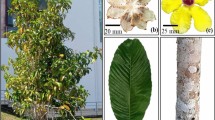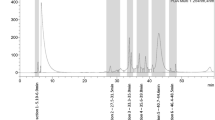Abstract
The methanol extract of the lichen Lasallia pustulata was tested for genotoxic, antioxidant, antimicrobial and anticancer activities. We did this using a cytokinesis block micronucleus (MN) assay on peripheral blood lymphocytes, by measuring free radical and superoxide anion scavenging activity, reducing power, determining of total phenolic compounds and determining the total flavonoid content, measuring the minimal inhibitory concentration by the broth microdilution method against five species of bacteria and five species of fungi and by using the microculture tetrazolium test on FemX (human melanoma) and LS174 (human colon carcinoma) cell lines. As a result of this study, we found that the methanol extract of L. pustulata did not modify the frequency of the MN and nuclear division index in comparison to untreated cells (p > 0.05). These results revealed that the methanol extract had moderate free radical scavenging activity with IC50 values of 395.56 μg/mL. Moreover, the extract tested had effective reducing power and superoxide anion radical scavenging. The values of the minimum inhibitory concentration against the tested microorganisms ranged from 0.625 to 20 mg/mL. In addition, the extract tested had strong anticancer activity against both cell lines with IC50 values of 46.67 and 71.71 μg/mL.
Similar content being viewed by others
References
Alves dos Santos R, Cabral TR, Cabral IR, Antunes LM, Pontes Andrade C, Cerqueira dos Santos Cardoso P, de Oliveira Bahia M, Pessoa C, Martins do Nascimento JL, Rodríguez Burbano R, Takahashi CS (2008) Genotoxic effect of Physalis angulata L. (Solanaceae) extract on human lymphocytes treated in vitro. Biocell 32:195–200
Anandjiwala S, Bagul MS, Parabia M, Rajani M (2008) Evaluation of free radical scavenging activity of an ayurvedic formulation, Panchvalkala. Indian J Pharm Sci 70:31–35
Bates ST, Cropsey GW, Caporaso JG, Knight R, Fierer N (2011) Bacterial communities associated with the lichen symbiosis. Appl Environ Microbiol 77:1309–1314
Behera BC, Verma N, Sonone A, Makhija U (2009) Optimization of culture conditions for lichen Usnea ghattensis G. Awasthi to increase biomass and antioxidant metabolite production. Food Technol Biotech 47:7–12
Culberson CF (1969) Chemical and botanical guide to lichen products. University of North Carolina Press, Chapel Hill, NC
Dobson F (2000) Lichens an illustrated guide. The Richmond publishing Co. Ltd, England
Dorman HJ, Bachmayer O, Kosar M, Hiltunen R (2004) Antioxidant properties of aqueous extracts from selected Lamiaceae species grown in Turkey. J Agric Food Chem 52:762–770
Farkaš V (2003) Structure and biosynthesis of fungal cell walls: methodological approaches. Folia Microbiol 48:469–478
Fenech M (2000) The in vitro micronucleus technique. Mutat Res 455:81–95
Fenech M (2007) Cytokinesis-block micronucleus cytome assay. Nat Protoc 2:1084–1104
Geyikoglu F, Turkez H, Aslan A (2007) The protective roles of some lichen species on colloidal bismuth subcitrate genotoxicity. Toxicol Ind Health 23:487–492
Goel M, Dureja P, Rani A, Uniyal PL, Laatsch H (2011) Isolation, characterization and antifungal activity of major constituents of the himalayan lichen Parmelia reticulata Tayl.†. J Agric Food Chem 59:2299–2307
Gordan MH (1990) Food antioxidants. Elsevier, London, New York
Gulcin I, Kurfrevioglu OI, Oktay M, Buyukokuroglu ME (2004) Antioxidant, antimicrobial, antiulcer and analgesic activities of nettle (Urtica dioica L.). J Ethnopharmacol 90:205–215
Halama P, van Haluwin C (2004) Antifungal activity of lichen extracts and lichenic acids. Biocontrol 49:95–107
Heijenoort J (2001) Formation of the glycan chains in the synthesis of bacterial peptidoglycan. Glycobiology 11:25–36
Hugo WB, Russell AD (1983) Pharmaceutical microbiology, 3rd edn. Blackwell Scientific Publications, Oxford
Kosanić M, Ranković B (2015) Lichen secondary metabolites as potential antibiotic agents. In: Ranković B (ed) Lichen secondary metabolites bioactive properties and pharmaceutical potential. Springer International Publishing, Switzerland, pp 81–104
Kosanić M, Manojlović N, Janković S, Stanojković T, Ranković B (2013) Evernia prunastri and Pseudoevernia furfuraceae lichens and their major metabolites as antioxidant, antimicrobial and anticancer agents. Food Chem Toxicol 53:112–118
Maciąg-Dorszyńska M, Węgrzyn G, Guzow-Krzemińska B (2014) Antibacterial activity of lichen secondary metabolite usnic acid is primarily caused by inhibition of RNA and DNA synthesis. FEMS Microbiol Lett 353:57–62
Manojlović N, Vasiljević P, Jusković M, Najman S, Janković S, Milenkovic-Andjelković A (2010) HPLC analysis and anticancer potential of extracts from the lichen, Thamnolia vermicularis var. Subuliformis. J Med Plants Res 4:817–823
Manojlović NT, Vasiljević PJ, Masković PZ, Jusković M, Bogdanović-Dusanović G (2012) Chemical composition, antioxidant and antimicrobial activities of lichen Umbilicaria cylindrica (L.) delise (Umbilicariaceae). Evid Based Complement Alternat Med 2012:1–8
Meda A, Lamien CE, Romito M, Millogo J, Nacoulma OG (2005) Determination of the total phenolic, flavonoid and proline contents in burkina fasan honey, as well as their radical scavenging activity. Food Chem 91:571–577
Milošević-Djordjević O, Stošić I, Stanković M, Grujičić D (2013) Comparative study of genotoxicity and antimutagenicity of methanolic extracts from Teucrium chamaedrys and Teucrium montanum in human lymphocytes using micronucleus assay. Cytotechnology 65:863–869
Mitrović T, Stamenković S, Cvetković V, Tošić S, Stanković M, Radojević I, Stefanović O, Čomić L, Đačić D, Ćurčić M, Marković S (2011) Antioxidant, antimicrobial and antiproliferative activities of five lichen species. Int J Mol Sci 12:5428–5448
Mosmann T (1983) Rapid colorimetric assay for cellular growth and survival: application to proliferation and anticancerity assays. J Immunol Methods 65:55–63
NCCLS (National Commitee for Clinical Laboratory Standards) (1998) Reference method for broth dilution antifungal susceptibility testing of conidium-forming filamentous fungi: proposed standard M38-P. NCCLS, Wayne, PA
Nishimiki M, Rao NA, Yagi K (1972) The occurrence of super-oxide anion in the reaction of reduced phenazine methosulfate and molecular oxygen. Biochem Biophys Res Commun 46:849–853
Odabasoglu F, Aslan A, Cakir A, Suleyman H, Karagoz Y, Halici M, Bayir Y (2004) Comparison of antioxidant activity and phenolic content of three lichen species. Phytother Res 18:938–941
Ohno M, Abe T (1991) Rapid colorimetric assay for the quantification of leukemia inhibitory factor (LIF) and interleukin-6 (IL-6). J Immunol Methods 145:199–203
Oyaizu M (1986) Studies on products of browning reaction prepared from glucoseamine. Jpn J Nutr 44:307–314
Paudel B, Bhattarai HD, Lee JS, Hong SG, Shin HW, Yim JH (2008) Antibacterial potential of Antarctic lichens against human pathogenic Gram-positive bacteria. Phytother Res 22:1269–1271
Purvis OW, Coppins BJ, Hawksworth DL, James PW, Moore DM (1992) The lichen flora of Great Britian and Ireland. Natural History Museum. Publications in association with the British Lichen Society, London
Ranković BR, Kosanić MM, Stanojković TP (2011) Antioxidant, antimicrobial and anticancer activity of the lichens Cladonia furcata, Lecanora atra and Lecanora muralis. BMC Complement Altern Med 20:97
Ranković B, Kosanić M, Stanojković T, Vasiljević P, Manojlović N (2012) biological activities of toninia candida and usnea barbata together with their norstictic acid and usnic acid constituents. Int J Mol Sci 13:14707–14722
Sarker SD, Nahar L, Kumarasamy Y (2007) Microtitre plate-based antibacterial assay incorporating resazurin as an indicator of cell growth, and its application in the in vitro antibacterial screening of phytochemicals. Methods 42:321–324
Sasikumar JM, Mathew GM, Teepica PDD (2010) Comparative studies on antioxidant activity of methanol extract and flavonoid fraction of Nyctanthes arbortristis leaves. Elec J Env Agricult Food Chem 9:227–233
Sawa T, Nakao M, Akaike T, Ono K, Maeda H (1999) Alkylperoxyl radical scavenging activity of various flavonoids and other phenolic compounds: implications for the anti-tumor promoter effect of vegetables. J Agric Food Chem 47:397–492
Shanab SMM, Shalaby EA, El-Fayoumy EA (2011) Enteromorpha compressa exhibits potent antioxidant activity. J Biomed Biotechnol 2011:726405. doi:10.1155/2011/726405
Sini H, Devi KS (2004) Antioxidant activities of chloroform extract of Solanum trilobatum. Pharm Biol 42:462–466
Slinkard K, Slingleton VL (1997) Total phenolic analyses: automation and comparison with manual method. Am J Enol Vitic 28:49–55
Triggiani D, Ceccarelli D, Tiezzi A, Pisani T, Munzi S, Gaggi C, Loppi S (2009) Antiproliferative activity of lichen extracts on murine myeloma cells. Biologia 64:59–62
Turkez H, Dirican E (2012) A modulator against mercury chloride-induced genotoxic damage: dermatocarpon intestiniforme (L.). Toxicol Ind Health 2828:58–63
Turkez H, Aydin E, Aslan A (2012a) Xanthoria elegans (Link) (lichen) extract counteracts DNA damage and oxidative stress of mitomycin C in human lymphocytes. Cytotechnology 64:679–686
Turkez H, Aydin E, Sisman T, Aslan A (2012b) Role of Peltigera rufescens (Weis) Humb. (a lichen) on imazalil-induced genotoxicity: analysis of micronucleus and chromosome aberrations in vitro. Toxicol Ind Health 28:492–498
Zeytinoglu H, Incesu Z, Tuylu BA, Turk AO, Barutca B (2008) Determination of genotoxic, antigenotoxic and anticancer potential of the extract from lichen Cetraria aculeata (Schreb.) Fr. in vitro. Phytother Res 22:118–123
Acknowledgments
The study was supported by the Ministry of Education, Science and Technological Development of the Republic of Serbia (Grant No. III41010; 173032, 175011).
Author information
Authors and Affiliations
Corresponding author
Rights and permissions
About this article
Cite this article
Kosanić, M., Ranković, B., Stanojković, T. et al. Lasallia pustulata lichen as possible natural antigenotoxic, antioxidant, antimicrobial and anticancer agent. Cytotechnology 68, 999–1008 (2016). https://doi.org/10.1007/s10616-015-9856-y
Received:
Accepted:
Published:
Issue Date:
DOI: https://doi.org/10.1007/s10616-015-9856-y




